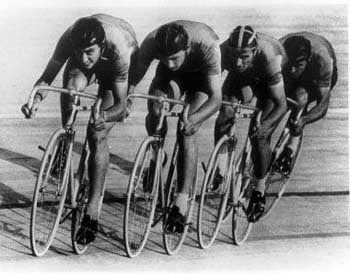Cino Cinelli, born in Montespertoli (near Florence) in 1916, was a successful bicycle racer in Italy, winning Milan-San Remo in 1943. Cino raced as independent pro (1937), and team pro for Fréjus (1938-39), Bianchi (1940-43) and Benotto (1944).
After WW II (1949) he started building frames by using some of the ideas he had created during those years of racing and founded company Cino Cinelli & C. in Milano specialized in distributing cycle racing accessories.
Cino assumed frames needs to be stiffer and the geometry to be to relaxed on most of the models of that era. He created a fork crown that had sloping shoulders and internal lugs allowing blades to become shorter and creating a stiffer fork and redesigned also the seat collar, bringing the seatstays behind the lug rather that along side it.
At this time Cinelli frames shows semi-sloping fork crown with or without point on outside of fork leg and seat cluster that is Frejus-style with separate seat tube collar and were soldered by Luigi Valsassina, whom Cino lured away from Bianchi in order to begin production of Cinelli frames with a planned output of round about 250 frames per year..
Previously Valsassina built frames for Fausto Coppi when he rode for Bianchi. Thus nobody should be surprised Fausto Coppi beeing the first who used these new features when he raced on a Cinelli frame in 1947.
Some years later Ole Ritter rode on a Cinelli frame when setting up the hour record in 1968.
Franco Testa, Mario Vallotto, Luigi Arienti and Mario Vigna set up an Olympic Record of 4:28:88 in the 1960th semifinals in Rome, where the Italian national cycling squad took six gold medals at all.
We won´t forget Viktor Kapitonov's legendary victory riding a Cinelli Mod. B at the 1960 Rome Olympics in which he first mistakenly thought of having won already only to discover that there was one lap remaining an then sprinting out the home town favorite to claim the gold medal in the Individual Road Race. Within all Adverts Kapitonov is presented riding a Modell S.C.
Even the US national team squad was riding Cinelli frames when pedaling for olympic honors.
Cinelli Frames were produced in small quantities only and used for Olympic and World Championship events from National Teams mainly. Please remember: When Cino founded his business in 1949 his enterprise begins by serving federations and clubs, which at this time represents the entire Italian racing market.
At the start of the Fifties Cino Cinelli & C became worldwide sales representative for Columbus tubing.
At the end of the Seventies Cino Cinelli, who has an eye towards retirement and watching Antonio Colombo and his Columbus tubes business grown in recent years, suggests that the two companies might have a vision and passion that would be able to let Cinelli & C.grow accordingly easy and fast.
Production processes and usage of the frames changed when Cinelli sold his company to the Colombo group in 1979 . Back then serial numbers start to run in sequence and to indicate the date of birth.
Mario Camilotto mentioned to have personally built every Cinelli Super Corsa from the time that Antonio Colombo stepped into Cinelli business until frame builder Giovanni Losa took over in the early 1990s, who did the job until 2008.
Within a Ron Kitching 1960 catalog the top of the line Modell S.C. ist refeerded to as a Super Corsa for the first time; prior to that the Modell S.C. always was called Speciale Corsa.
In 1963 "serial" production of Modell S.C. with Reynolds 531 main tubes and Columbus fork and stays ends and Cinelli switched to Columbus SL (Strada Leggera) tubing overall; but Reynolds 531 main tubes were still available on request. The Mod. B was made out of Columbus main tubes and Falck fork and stays.
It might have been the time when Valsassina retired and Chirico took over soldering frames until he was superseded by Mario Camilotto in round about 1978/79.
For older Cinelli frames the most significant keys in dating the frame are:
- Campagnolo Sport derailleur spring anchor-hole no longer appears in rear dropout in about 1965
- Frames no longer supplied with chrome Cinelli "Supercorsa" headset and chrome Cinelli bottom bracket (track bike supplied with clip-style headset) in about 1965.
- The Bottom Bracket Oil Port disappeared in about 1965
- Campagnolo dropout loses "boss" for the Sport derailleur spring hole in late 60s
- The 3 holes in the lugs appeared in about 1968.
In the period of 1972 to 76 a special made to order Mod. S.C. Leggerissimo was made for Radsport Brugelmann in Frankfurt, Germany; These frames allways were colored yellow with red head tube and show six holes arranged in circle with the seventh hole in center at the bottom of BB shell.
Additionally you might be able to date your frame by having a look at the Cinelli head badge also. These differ as pointed out below:
1949 - 1958 56mm Cinelli crest paint-filled silver-plate over brass head badge
1958 - 1971 51mm Cinelli crest paint-filled silver-plate over brass head badge
1971 - 1978 Cinelli crest anodized aluminum head badge
1978 - 1979 Cinelli crest decal head badge
since 1979 - today Flying C decal head badge
The Mod. Riviera was originally built for the English and German markets by a builder from Monza, who never built under his own name, according to an interview with Andrea Cinelli. Over the years the Riviera was built by various companies later on, including Garlatti in Parma. Additionally Cinelli offered juvenile bikes, boys and girls Rivieras, along with city bikes (Condorino), all made by various companies over the years, but the Mod. S.C. and Mod. B were always made in house.
Please stay tuned to see a 1963 build Tipo Super Corsa reassembled and to be pedaled around nice places in Vienna.




No comments:
Post a Comment